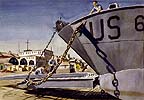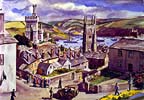Dwight C. Shepler #125
Watercolor, April, 1944
88-199-DX
Ancient
Cornwall Watches
Dwight C. Shepler #125
Watercolor, April, 1944
88-199-DX
Warships were no novelty to St. Mawes Castle, which has brooded over the waters of Falmouth Harbor for 400 years. The LSTs (Landing Ship, Tank) shown entering the harbor behind a U.S. minesweeper of the Revon class were a 1944 expression of the kind of invasive naval forces which this castle was built to repulse. But the castle would be about as much use as an umbrella against these ships.
When King Henry VIII of England constructed this artillery fort (as well as Pendennis Castle across the bay and many others) as part of his new coastal defense system in the 16th century, his measures were sweeping and extraordinary. Although a national monument in peacetime, the castle was used as a Royal Air Force auxiliary headquarters during World War II.
 Platypus
of Falmouth
Platypus
of Falmouth
Dwight C. Shepler #129
Watercolor, 1944
88-199-EB
Shifters of the busy U.S. Navy maintenance yard at Falmouth, Cornwall, rigged ramp extensions on a LCT for the launching of amphibious tanks. This Landing Craft Tank was supported on a "hard," a concrete apron which extended down below tide level like a boat ramp and approximated the slope of a beach, thus allowing the craft to be loaded while in an otherwise deep-water port. New hards were built in ports throughout southern England for the mammoth task of loading the forces of attack.
 Uneasy
Peace – Fowey
Uneasy
Peace – Fowey
Dwight C. Shepler #131
Watercolor, 1944
88-199-ED
Slumbering old ports heard the engines of countless amphibious craft echoing from the ancient buildings, which climbed the hillsides of this British town. Spring was painfully lovely, for a good spring meant good invasion weather.
 St.
Mawes Rendezvous
St.
Mawes Rendezvous
Dwight C. Shepler #130
Watercolor, May 1944
88-199-EC
Instead of fishing boats, assault craft of the U.S. Navy milled about the little harbor of St. Mawes in May of 1944. They then departed for a rendezvous with LSTs in preparation for a practice landing on a beach some miles away. Life in this sunny village of the Cornish coast went on somewhat as usual and, except for the ominous meaning of the maritime activity, had all the attributes of a lotus-eater’s existence.
 The
Coast Inhabitants Wondered
The
Coast Inhabitants Wondered
Dwight C. Shepler #126
Watercolor, 1944
88-199-DY
Time and again during the months preceding the invasion, the weird craft of modern amphibious warfare stood out through ancient harbor mouths of Devon and Cronwall, laden with troops and tanks. Mariners, too old for the sea, and women and children always watched, wondering if this could be The Day.
From many ports the craft met in massive rendezvous off Dartmouth and hit the battered beaches of Slapton in full-scale and thunderous attack. One day, the vessels held their course for the continent.
 Attack
on Slapton Sands
Attack
on Slapton Sands
Dwight C. Shepler #127
Watercolor, May, 1944
88-199-DZ
The long beach at Slapton and its evacuated hinterland was the great practice ground for the invasion of Europe. During many months U.S. forces attacked with heavy bombardment and live ammunition in large-scale maneuvers.
The first wave penetrated into the hills, where flame-throwers and demolitions were used. A support wave landed tanks and equipment from LCTs, and engineers set off a smoke screen for cover. Tanks stayed at the water’s edge to give support fire until land mines were cleared. The battered manor house and farm buildings were pathetic reminders of evacuated civilian residents.
 Assault
Loading ¾ Appledore
Assault
Loading ¾ Appledore
Dwight C. Shepler #135
Watercolor, May 1944
88-199-EH
A U.S. Navy beach master directed the loading of light and medium tanks of the U.S. Army Assault Training Center. On an incoming tide, Mark-6 LCTs took aboard the cargo which would assault the beach at Woolacombe a few miles away. Because this beach was flat, the landing craft grounded some distance out. The tanks were waterproofed so that they could wade through the intervening water. Their machinery was sealed in asbestos compound and the big vents elevated air intakes enough so that the tanks could enter water as much as six feet deep and still operate.
British
LCT in English Port
Alexander P. Russo #10
Watercolor, June 1944
88-198-J
This ship was one of the many landing craft that made up the mighty Allied sea armada, which sailed for France on D-Day.
1 2 3 4 5 6 7 8 9 10 11 12 13 14 15 16 17 18 19 20 21 22 23 24 25